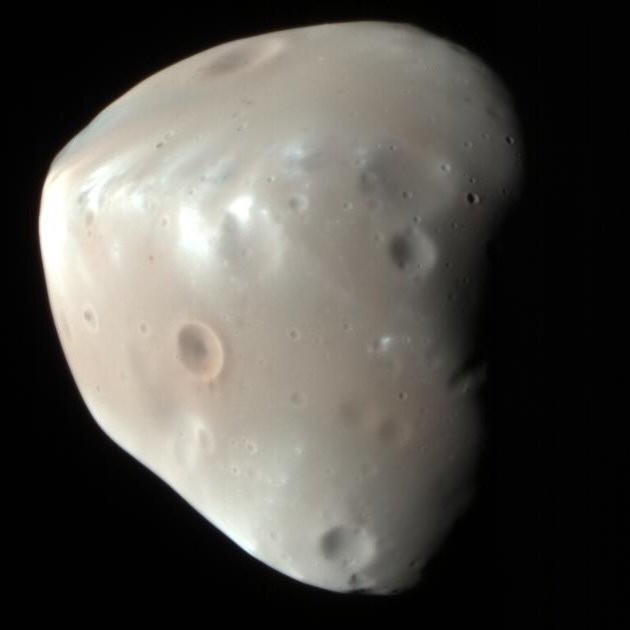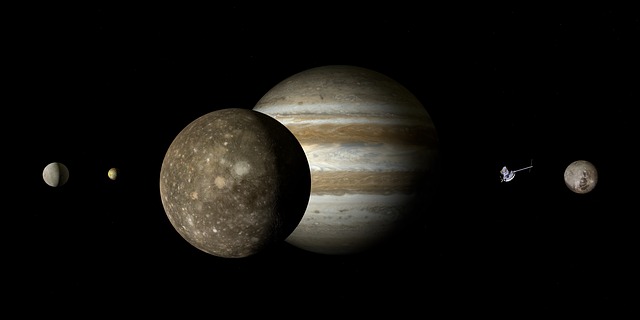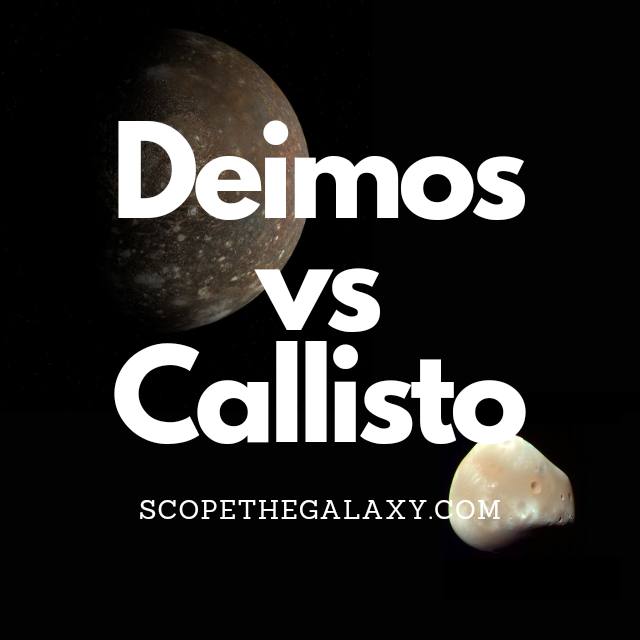*This post may contain affiliate links. This means we may make a commission if you purchase an item using one of our links*
The main differences between Deimos and Callisto are that Callisto orbits Mars while Callisto orbits Jupiter, Callisto is bigger with a diameter of 4,820.6km while Deimos has a diameter of 12.3km and Callisto is amongst the most cratered celestial bodies in our entire solar system while Deimos is not.
There are various differeneces between these two so, continue reading if you want a more detailed breakdown of both bodies along with their similarities and differences below.
What Is The Moon Deimos?
Table of Contents

Deimos is the smaller and outermost of the two moons of Mars, named after the Greek God of dread and terror (the brother of Phobos). This satellite was also discovered by American astronomer Asaph Hall just five days before Phobos (12th August 1877).
Scientists like Johannes Kepler had put forward theories for the existence of these moons many years before they were discovered. Their calculations were based on the fact that the planets on either side (Earth and Jupiter) possessed one and four moons, respectively.
Still, none were discovered until the 19th century. One of the main reasons for this is that the tiny size of Phobos and Deimos, combined with an exceptionally close orbit to their planet, means that the glare of Mars often obscures our view of them.
Phobos measures just 15 x 12 x 11 km and completes an orbit of Mars once every 30 hours.
This tiny moon is also a heavily cratered landscape shaped by the impact of asteroid collisions over time. However, the material thrown up from these impacts doesn’t appear to have landed back on the moon’s surface as it usually would. This could be because the lack of gravity on Phobos allowed the ejected material into space.
The surface gravity on Deimos is just 0.003 m/s^2 (compared to 9.807 m/s^2 on Earth), which means the average gravitational pull of Deimos is only 0.003 m/s. With only 1/2500th of Earth’s gravity, you would need a tether to walk on this rocky moon, or every step would put you at risk of achieving escape velocity and launching yourself into space.
The composition of Deimos is similar to Phobos, suggesting that it might also be a captured asteroid. Its surface is very dark gray and has an albedo of around 0.07, meaning it reflects just 7% light (about half of the light Earth’s moon can reflect).
What Is The Moon Callisto?

Callisto is one of the large moons orbiting Jupiter, the outermost of the Galilean moons, first discovered on 7th January 1610. The surface of this icy world is frozen, but scientists believe an underground ocean could reside beneath the ice.
Even if there’s water on Callisto, it won’t necessarily hold life because the surface is so old. Scientists will need to conduct more research into the moon before determining whether this is a likely possibility.
The ESA’s JUICE (Jupiter Icy Moon Explorer) mission is focused on the three ice moons of Jupiter. It is expected to arrive in 2030 and will focus on learning more about the environment of each, as well as their potential for hosting life.
Scientists estimate that Callisto is around 4.5 billion years old (the same age as Jupiter), and its average distance from the Sun is approximately 778 million km. It has a diameter of 4,820.6km, which makes it similar in size to the planet Mercury, and the average temperature is a frigid minus 139.2 degrees Celsius.
Callisto takes seven days to orbit its planet at an average distance of 1,880,000km, and it is tidally locked, meaning the same side of it always faces Jupiter. But this moon experiences less tidal influence than the other Galilean moons because it lies in the orbit of Jupiter’s primary radiation belt.
The name of this moon is derived from the stories of Greek myth. Callisto was the nymph who had an affair with Zeus, the King of the Gods. Upon hearing this news, Zeus’ wife Hera turned Callisto into a star and placed her in the Ursa Major constellation. Interestingly, every moon of Jupiter is named after a Greek figure who Zeus seduced.
Callisto may be the third biggest moon and similar in size to the planet Mercury, but it only has a mass of 107,593,737,963.819 billion kg. That may sound like a lot, but it’s only ⅓ the mass of the similarly sized Mercury.
You may wonder why scientists classify Callisto as a “moon” rather than a planet if it’s almost the same size as Mercury. The reason is simple; planets must orbit the sun, but Callisto orbits one of the planets.
The composition of this frigid world is around 60% rock and iron and 40% ice. The moon has roughly equal amounts of rock and ice, plus the potential for water below the surface. There are also traces of carbon dioxide, organic compounds, and silicates.
This moon is one of the oldest landscapes in the Milky way and the most heavily cratered body in our system. However, scientists believe this could now be a “dead” moon as there are no longer any signs of volcanism or plate tectonics on its surface.
Similarities Between Deimos And Callisto
As both are natural satellites, Phobos and Ganymede do share a few similarities, which includes the following:
- Both have a rocky, terrestrial surface.
- Neither have rings surrounding them.
- Both are tidally locked to their planet.
- Both orbit their planet in an elliptical pattern.
- Neither have tectonic plates.
- Neither have a magnetic field.
- Callisto and Deimos have a practically non-existent axial tilt.
Differences Between Deimos And Callisto
As for the differences between the two, they include the below.
- Deimos orbits Mars whilst Callisto orbits Jupiter.
- Callisto is a spherical shape while Deimos is not.
- Callisto has a diameter of 4,820.6km whilst Deimos has a diameter of 12.4km.
- Deimos has no atmosphere whilst Callisto has a very thin atmosphere composed of oxygen and hydrogen.
- A day on Deimos takes 30 hours whilst a Callisto day takes 17 days.
- It takes Deimos 30 hours to orbit Mars and around the Sun in 687 days whilst Callisto orbits Earth in 17 days and the Sun in 12 years.
- Deimos’ temperature ranges between -4 to -112 degrees Celsius whilst Callisto’s is around -139.2 degrees Celsius.
- Callisto’s density is 1.83 g/cm³ whilst Deimos density is 1.47 g/cm³.
- Callisto’s mass is 1.07 x 10^23 kg whilst Deimos’ mass is 1.4762 × 10^15 kg.
- Deimos’ gravitational strength is 0.003 m/s² whilst Callisto’s is 1.236 m/s².
- Callisto orbits Jupiter at an average distance of 1.88 million km whilst Deimos is 24,680km away from Mars
- Callisto has a central core while Deimos does not.
- Callisto is amongst the most heavily cratered entities in our solar system.
Summary
As both are moons, they do share a fair few things such as their rocky exterior, the fact both orbit a planet and are also tidally locked to said planets, but they are very different from each other too.
Whether it be in regards to size, mass, gravitational strength, density, the number of craters that are present within their surfaces among other things so, despite the commonalities Callisto and Deimos share, they are still easily distinguishable and can be told apart id you were to put them in a line up.

